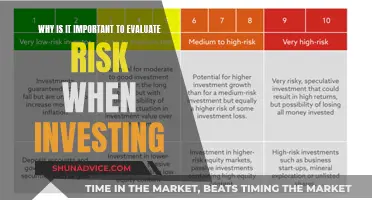
Diversifying your savings and investment portfolio is a crucial aspect of financial planning. The core principle behind diversification is not putting all your eggs in one basket, which means that instead of investing heavily in a single stock, industry, or asset, it is wiser to spread your investments across various options. This strategy helps manage risk and enhance stability. By investing in multiple stocks, industries, countries, and risk profiles, as well as other assets like bonds, commodities, and real estate, you reduce the chances of permanent capital loss and lower the volatility of your portfolio.
While diversification may lead to slightly lower returns compared to a single winning stock, it is a safer strategy that protects you from significant losses. It is important to remember that investing is an art, not a knee-jerk reaction, and a well-diversified portfolio, combined with a long-term investment horizon, can weather most market storms.
| Characteristics | Values |
|---|---|
| Purpose | Reduce risk of losing money |
| How it works | Combine different investments to reduce overall risk |
| Investment types | Stocks, bonds, cash, commodities, real estate, mutual funds, ETFs, index funds, target-date funds, money market securities, life insurance, and more |
| Number of investments | At least 25 stocks |
| Industries | Pharmaceuticals, education technology, information technology, tech, energy, healthcare, and more |
| Risk profiles | High-risk, high-return vs. stable, lower-return |
| Investor age | Younger investors can take more risk, older investors should reduce risk exposure |
| Investor circumstances | Family finances and expenses should be considered |
| Investor knowledge | Understand factors that impact financial markets, including interest rates, inflation, and central bank policies |
| Investor behaviour | Avoid knee-jerk reactions, constant trading, and chasing performance |
| Investor discipline | Regularly review and rebalance portfolio |
What You'll Learn

Spread your investments across different industries and sectors
Diversifying your portfolio by spreading your investments across different industries and sectors is a crucial aspect of building a robust investment strategy. Here are some key reasons why:
Risk Mitigation
Diversification helps to reduce the impact of adverse events or downturns specific to any one industry or sector. By allocating your investments across multiple sectors, you lower the chances of suffering significant losses if a particular industry experiences a decline. For example, during an economic downturn, consumer discretionary stocks may suffer due to reduced spending on non-essentials, while healthcare and consumer staples stocks tend to remain stable. By investing in a mix of sectors, you can potentially offset losses in one area with gains in another.
Maximizing Returns
Sector diversification allows you to capitalize on the growth potential of various industries. By spreading your investments, you increase your exposure to industries experiencing growth and can benefit from emerging trends and advancements in different sectors. For instance, investing in technology companies alongside traditional sectors like finance or manufacturing enables you to benefit from innovations and digital transformations.
Stability and Resilience
Diversification enhances the overall stability and resilience of your portfolio. By allocating your investments across sectors such as healthcare, consumer goods, finance, and energy, you reduce the impact of any downturn in a particular industry. This approach ensures that even if one sector underperforms, others may still be thriving, thus balancing out your overall portfolio performance.
Capturing Growth Opportunities
Different sectors thrive under varying market conditions. For example, technology companies benefit from innovation and digital transformation, while consumer staples are resilient during economic downturns. Sector diversification allows you to capture growth opportunities across the economic landscape and take advantage of emerging sectors like renewable energy or education technology.
Hedging Against Industry-Specific Risks
Industries are influenced by various factors, including government regulations, technological advancements, and changing consumer preferences. By spreading your investments across sectors, you reduce your exposure to industry-specific risks. For instance, if a new government policy negatively impacts the automotive sector, a diversified portfolio with holdings in other industries like renewable energy or healthcare may fare better.
Long-Term Success
Sector diversification is a key component of long-term financial success. It helps you reduce exposure to industry-specific risks, increase overall portfolio stability, and potentially enhance returns. Remember to conduct thorough research, monitor industry trends, and adjust your sector allocations as needed to optimize your diversification strategy.
Investment Options for College Savings: What Are Your Choices?
You may want to see also

Include a mix of stocks and bonds in your portfolio
Stocks and bonds are two of the most common asset classes, and including them in your portfolio is a great way to diversify your savings and investments. Here are some reasons why you should include a mix of stocks and bonds:
Risk Management:
Stocks and bonds have different risk profiles. Stocks are typically considered riskier investments, offering the potential for higher returns but also carrying a higher risk of loss. On the other hand, bonds are generally seen as more stable and less volatile, providing a steady source of income with lower returns. By including both in your portfolio, you can balance the risk and return of your investments.
Age and Risk Tolerance:
The mix of stocks and bonds in your portfolio should align with your age and risk tolerance. Younger investors, who have a longer time horizon, can afford to take on more risk by allocating a larger portion of their portfolio to stocks. As investors get older, it is generally recommended to reduce the stock allocation and increase the bond allocation to preserve capital and generate stable income. A common rule of thumb is to subtract your age from 100 to determine the percentage of stocks in your portfolio.
Market Conditions:
Different market conditions can favour either stocks or bonds. During economic booms, stocks tend to perform well, while bonds may offer a hedge against market volatility and uncertainty. In times of economic downturn or high inflation, the stable and fixed returns of bonds can provide a safer investment option. By having a mix of stocks and bonds, you can navigate changing market conditions effectively.
Investment Goals:
The mix of stocks and bonds should also be aligned with your investment goals and time horizon. If you have short-term financial goals, a more conservative approach with a higher allocation to bonds may be suitable. For long-term goals like retirement planning, a growth portfolio with a higher allocation to stocks may be recommended to achieve the desired returns.
Diversification Strategies:
Within the broad categories of stocks and bonds, there are further diversification strategies you can employ. For stocks, you can diversify across large-cap, mid-cap, and small-cap stocks, as well as international and emerging markets. For bonds, you can invest in government, corporate, or municipal bonds with different maturity dates and credit ratings. This micro-level diversification can help reduce risk and improve the overall performance of your portfolio.
Retirement Investments: Best Places for Your Savings
You may want to see also

Diversify within each type of investment
Diversification is a crucial aspect of investment planning and management. It involves spreading your investments across various assets and industries to reduce the overall risk of your portfolio. While diversification does not guarantee against losses, it is widely considered the most effective approach to achieving long-term financial goals while minimising risk. Here are some ways to diversify within each type of investment:
Diversify Across Different Industries and Sectors:
Diversifying your investments across multiple industries and sectors can help reduce the impact of industry-specific risks. For example, investing in both the transportation and streaming services sectors can hedge against risks specific to the travel industry, such as an indefinite pilots' strike.
Diversify Across Companies:
It is important to diversify your investments across different companies, even within the same industry. For instance, investing in multiple airline providers instead of just one can reduce company-specific risks, such as those associated with a revolutionary leader leaving the company.
Diversify Across Asset Classes:
Different asset classes, such as stocks, bonds, real estate, and cryptocurrency, tend to respond differently to macroeconomic conditions. For instance, rising interest rates may negatively impact bond prices but could lead to increases in rent for real estate.
Diversify Geographically:
Investing in companies and holdings across different countries and regions can help mitigate political, geopolitical, and international risks. For example, investing in Japanese equities and Australian bonds can provide some protection against losses during an economic downturn in the United States.
Diversify Across Time Frames:
Consider diversifying your investments based on their time frames. Short-term investments, like short-term bonds, tend to be more liquid and yield lower returns, while long-term investments, like long-term bonds, often carry higher inherent risk but can deliver higher returns.
Diversify Across Market Capitalisations:
Diversifying across different market capitalisations, such as large-cap and small-cap stocks, can provide a balance between growth potential and stability. Large-cap stocks tend to be safer, while small-cap stocks have more room to grow.
Remember, diversification aims to reduce unsystematic risk, which is specific to a company, industry, market, economy, or country. However, it is important to note that diversification may also lower potential returns as it focuses on risk reduction rather than maximising absolute returns.
Yotta Savings: A Smart Investment Strategy for Your Money
You may want to see also

Consider investing in money market securities for cash
Diversification is a crucial aspect of any investment strategy, and it involves spreading your investments across various asset classes, sectors, and industries to reduce risk. One option to consider as part of your diversification strategy is investing in money market securities for cash. Here are four to six paragraphs explaining this in more detail:
Money market instruments, such as certificates of deposit (CDs), commercial papers (CPs), and treasury bills (T-bills), offer a safe and liquid option for investors. These securities are known for their ease of liquidation and low risk, making them ideal for those seeking stable, short-term investments. Issued by the Reserve Bank of India, T-bills are backed by the central government and are considered almost risk-free. While they may not offer high returns, they are a secure option for investors, especially when paired with riskier investments.
Money market funds are a type of mutual fund that invests in highly liquid, short-term debt instruments. These funds aim to provide investors with high liquidity and low risk. One of their key features is maintaining a net asset value (NAV) of $1 per share, which offers stability and regular income for investors. Money market funds are ideal for those seeking a safe and liquid investment option for their cash reserves, but it's important to note that they may not be suitable for long-term investment goals like retirement planning due to their low capital appreciation.
Money market funds are a popular choice for investors looking to park their cash temporarily. They are often used as a holding place before investing elsewhere or making anticipated cash outlays. These funds are regulated and considered relatively safe, with only a few instances of dipping below the $1 NAV, known as "breaking the buck," which was quickly corrected. Money market funds are a good option for those seeking a diversified, professionally managed portfolio with high liquidity.
Compared to money market accounts (MMAs), money market funds are investment products that may not be FDIC-insured and have a fluctuating principal value. While MMAs are savings accounts with higher interest rates, money market funds offer more liquidity and easier withdrawal options. Money market funds are also more accessible to individual investors due to their smaller minimum investment amounts.
Money market funds are a good option for those seeking lower market risk and stable returns. They are ideal for short-term savings goals, such as weddings, down payments on homes, or emergency funds. These funds are easily transferable between bank and investment accounts and typically have a stable $1 NAV. It's important to note that while money market funds are less risky than stocks or bonds, there is still a possibility of losing money, and capital preservation is not guaranteed.
Overall, investing in money market securities for cash can be a valuable part of a diversified investment portfolio. They offer safety, liquidity, and stable returns, making them a good option for short-term savings goals and cash reserves. However, it's important to consider their low capital appreciation and potential impact of interest rate fluctuations when including them in your investment strategy.
529 Savings Plans: Smart Investment Strategies, per Forbes
You may want to see also

Rebalance your portfolio periodically
Diversifying your savings and investment portfolio is a crucial step in achieving your financial goals and minimising risk. One key aspect of this is periodically rebalancing your portfolio to ensure it stays aligned with your risk tolerance and investment strategy. Here are some detailed instructions on how to rebalance your portfolio:
Define your financial goals, timeline, and risk tolerance:
Start by assessing your financial objectives, the time horizon for your investments, and the level of risk you are comfortable with. This foundation will help you determine the appropriate mix of assets, such as stocks, bonds, cash, and other investments.
Determine your ideal portfolio mix:
Decide on the specific allocation of each asset class in your portfolio. For example, you might allocate 70% to stocks and 30% to bonds, or adjust this ratio based on your age and risk appetite. This initial allocation will serve as the benchmark for future rebalancing.
Set a rebalancing schedule:
You can choose to rebalance your portfolio at regular intervals, such as annually or quarterly, or when your asset allocation deviates by a certain percentage (e.g., 5%) from your desired mix. The frequency depends on your preferences, transaction costs, and tax considerations, and how actively you want to manage your portfolio.
Track and compare your current portfolio:
Maintain records of your portfolio's performance and the current allocation of each asset class. Compare this with your desired allocation to identify any significant deviations. There are tools and investment monitors available to help you with this step, or you can use a spreadsheet.
Make adjustments:
If your portfolio has drifted from your desired allocation, you can rebalance by buying or selling assets to return to your target mix. You can do this by adding new money to the underweighted asset class or using withdrawals to decrease the weight of the overweight asset. For example, if your portfolio has become overweight in stocks, you can sell a portion of your stocks and use the proceeds to buy bonds.
Consider the tax implications:
Be mindful of the taxes incurred when selling profitable investments. In some cases, you may opt to avoid selling and instead adjust your future contributions, directing new funds towards the underweighted asset classes to gradually rebalance your portfolio over time.
Stick to your plan:
Create a personal investment policy statement that outlines your investment mix, asset allocation, and rebalancing parameters. It's important to remain disciplined and stick to your predetermined plan, avoiding the urge to make frequent trades based on short-term market fluctuations.
Review and repeat:
Periodically review your portfolio to ensure it remains aligned with your financial goals and risk tolerance. Depending on your circumstances, you may need to adjust your investment strategy or rebalance your portfolio more or less frequently.
By following these steps, you can effectively rebalance your portfolio, ensuring that it remains diversified, adheres to your risk tolerance, and helps you stay on track to achieve your financial objectives.
Savings and Investments: Smart Money Strategies for Beginners
You may want to see also
Frequently asked questions
Diversifying your portfolio helps to manage risk and minimise losses. The idea is that if one investment loses money, the others will make up for those losses.
Diversification includes owning stocks from several different industries, countries, and risk profiles, as well as other investments such as bonds, commodities, and real estate.
Diversification can improve returns for the level of risk chosen and has the potential to reduce volatility.







